 Wargame publisher Avalon Hill’s subsidiary Microcomputer Games Inc. releases the computer role playing game Telengard for the Apple II computer. It promptly consumes the webmaster’s entire summer.
Wargame publisher Avalon Hill’s subsidiary Microcomputer Games Inc. releases the computer role playing game Telengard for the Apple II computer. It promptly consumes the webmaster’s entire summer. ![]()

 Wargame publisher Avalon Hill’s subsidiary Microcomputer Games Inc. releases the computer role playing game Telengard for the Apple II computer. It promptly consumes the webmaster’s entire summer.
Wargame publisher Avalon Hill’s subsidiary Microcomputer Games Inc. releases the computer role playing game Telengard for the Apple II computer. It promptly consumes the webmaster’s entire summer. ![]()
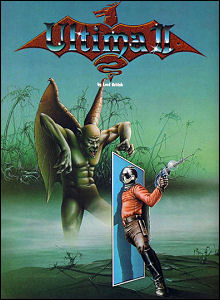 Sierra releases the computer role playing game game Ultima II: Revenge Of The Enchantress for the Apple II home computer. Written by Richard “Lord British” Garriott, this is the second volume of the best-selling Ultima series of RPGs, and the first to introduce space travel and science fiction elements into the games’ sword-and-sorcery fantasy setting.
Sierra releases the computer role playing game game Ultima II: Revenge Of The Enchantress for the Apple II home computer. Written by Richard “Lord British” Garriott, this is the second volume of the best-selling Ultima series of RPGs, and the first to introduce space travel and science fiction elements into the games’ sword-and-sorcery fantasy setting. ![]()
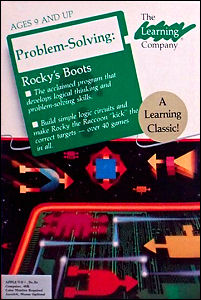 The Learning Company tries on Rocky’s Boots, an innovative educational computer game designed to teach players the basics of circuit diagrams and basic logic by designing virtual machines to kick specific objects on screen. The game is designed by Warren Robinett, a former Atari programmer whose previous claim to fame is the hit game Adventure.
The Learning Company tries on Rocky’s Boots, an innovative educational computer game designed to teach players the basics of circuit diagrams and basic logic by designing virtual machines to kick specific objects on screen. The game is designed by Warren Robinett, a former Atari programmer whose previous claim to fame is the hit game Adventure. ![]()
 Trying to join the ranks of game companies producing home computers, Mattel Electronics licenses a low-end computer from a Hong Kong manufacturer and releases it in the United States as the Aquarius home computer. The age of Aquarius is short-lived, however, as Mattel is incurring serious losses from slowing Intellivision sales, and the Aquarius computer quickly proves to be underpowered next to even its cheapest competitors (the Mattel programmers tasked with creating games and software for it refer to it as the “system for the ’70s”).
Trying to join the ranks of game companies producing home computers, Mattel Electronics licenses a low-end computer from a Hong Kong manufacturer and releases it in the United States as the Aquarius home computer. The age of Aquarius is short-lived, however, as Mattel is incurring serious losses from slowing Intellivision sales, and the Aquarius computer quickly proves to be underpowered next to even its cheapest competitors (the Mattel programmers tasked with creating games and software for it refer to it as the “system for the ’70s”). ![]()
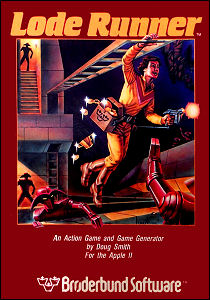 Broderbund Software introduces the earliest versions of Doug Smith’s computer game Lode Runner, including the Apple II version. Inspired by the obscure arcade game Space Panic, Lode Runner gives players a weapon that digs rather than directly disabling enemies. A game franchise spanning multiple platforms and decades is spawned.
Broderbund Software introduces the earliest versions of Doug Smith’s computer game Lode Runner, including the Apple II version. Inspired by the obscure arcade game Space Panic, Lode Runner gives players a weapon that digs rather than directly disabling enemies. A game franchise spanning multiple platforms and decades is spawned. ![]()
 Broderbund Software introduces the earliest versions of Doug Smith’s computer game Lode Runner, including the Atari Home Computer version. Inspired by the obscure arcade game Space Panic, Lode Runner gives players a weapon that digs rather than directly disabling enemies. A game franchise spanning multiple platforms and decades is spawned.
Broderbund Software introduces the earliest versions of Doug Smith’s computer game Lode Runner, including the Atari Home Computer version. Inspired by the obscure arcade game Space Panic, Lode Runner gives players a weapon that digs rather than directly disabling enemies. A game franchise spanning multiple platforms and decades is spawned. ![]()
 Origin Systems releases the computer role-playing game Ultima III: Exodus for the Apple II home computer, the third game in Richard Garriott’s Ultima series.
Origin Systems releases the computer role-playing game Ultima III: Exodus for the Apple II home computer, the third game in Richard Garriott’s Ultima series. ![]()
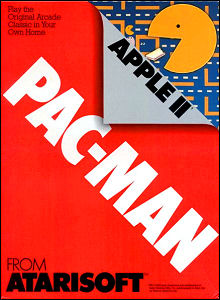 Atari, under its Atarisoft imprint, releases the Apple II port of Pac-Man, largely reusing the code of the earlier H.A.L. Labs title Taxman.
Atari, under its Atarisoft imprint, releases the Apple II port of Pac-Man, largely reusing the code of the earlier H.A.L. Labs title Taxman. ![]()
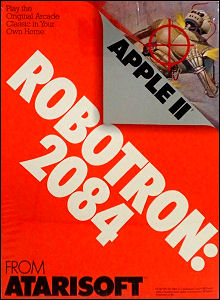 Atari, under its Atarisoft imprint, releases the Apple II port of Robotron: 2084.
Atari, under its Atarisoft imprint, releases the Apple II port of Robotron: 2084. ![]()
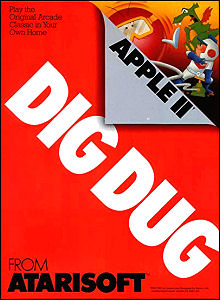 Atari, under its Atarisoft imprint, releases the Apple II port of Dig Dug.
Atari, under its Atarisoft imprint, releases the Apple II port of Dig Dug. ![]()
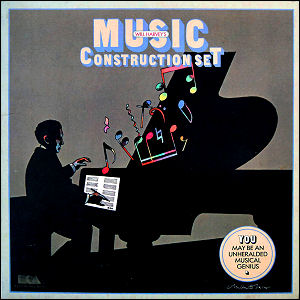 Electronic Arts releases Will Harvey’s Music Construction Set for the Apple II (versions will follow for other systems, such as the Atari home computers and Commodore 64, but the Apple II version is the first released, with users advised that the software works best with the Mockingboard music and audio peripheral).
Electronic Arts releases Will Harvey’s Music Construction Set for the Apple II (versions will follow for other systems, such as the Atari home computers and Commodore 64, but the Apple II version is the first released, with users advised that the software works best with the Mockingboard music and audio peripheral). ![]()
 The third and final game in Epyx’s “Apshai trilogy” is released for various home computer platforms. Gateway To Apshai continues the trend of pushing traditionally turn-based computer RPGs toward real-time action games, a trend that will culminate in the smash success of the unrelated NES game The Legend Of Zelda years later.
The third and final game in Epyx’s “Apshai trilogy” is released for various home computer platforms. Gateway To Apshai continues the trend of pushing traditionally turn-based computer RPGs toward real-time action games, a trend that will culminate in the smash success of the unrelated NES game The Legend Of Zelda years later. ![]()
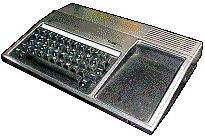 After a six-month loss totaling over $200,000,000, Texas Instruments puts its computer division out of its misery immediately, ending all manufacturing and support for the TI 99/4a home computer. Prices on the remaining stock of TI computers drop well below the $100 mark, and the company lays off thousands of employees; third-party software and peripheral vendors such as Milton Bradley take a hit by the end of the year as a result. Company executives describe TI’s losses in 1983 so far as the worst that the company has ever suffered.
After a six-month loss totaling over $200,000,000, Texas Instruments puts its computer division out of its misery immediately, ending all manufacturing and support for the TI 99/4a home computer. Prices on the remaining stock of TI computers drop well below the $100 mark, and the company lays off thousands of employees; third-party software and peripheral vendors such as Milton Bradley take a hit by the end of the year as a result. Company executives describe TI’s losses in 1983 so far as the worst that the company has ever suffered.
 Having taken heavy losses and criticism from both the public and the computing press for launching an underpowered machine into the burgeoning personal computer market, Mattel Electronics hurriedly sells off its interest in the Aquarius Computer, handing all rights in the machine back to its UK-based originator, Radofin Electronics. The age of Aquarius has lasted less than a year, but has cost Mattel Electronics dearly.
Having taken heavy losses and criticism from both the public and the computing press for launching an underpowered machine into the burgeoning personal computer market, Mattel Electronics hurriedly sells off its interest in the Aquarius Computer, handing all rights in the machine back to its UK-based originator, Radofin Electronics. The age of Aquarius has lasted less than a year, but has cost Mattel Electronics dearly.
 Apple Computer releases a new home and business computer, the Macintosh, with a sharp black & white display and an eye-grabbing, object-oriented graphical user interface. Early software includes the what-you-see-is-what-you-get (WYSIWYG) word processor MacWrite and the graphics program MacPaint, the combination of which jumpstarts an entire new industry, “desktop publishing” – typesetting via computer instead of manual layout. This decisive step away from the now-seven-year-old Apple II architecture is Apple’s answer to the IBM PC.
Apple Computer releases a new home and business computer, the Macintosh, with a sharp black & white display and an eye-grabbing, object-oriented graphical user interface. Early software includes the what-you-see-is-what-you-get (WYSIWYG) word processor MacWrite and the graphics program MacPaint, the combination of which jumpstarts an entire new industry, “desktop publishing” – typesetting via computer instead of manual layout. This decisive step away from the now-seven-year-old Apple II architecture is Apple’s answer to the IBM PC.
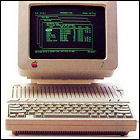 Not quite ready to bring the Apple II line to an end, Apple Computer launches the Apple IIc, a smaller form-factor enhanced Apple IIe specifically designed for portability (an optional LCD monitor – with no backlighting – is also made available on this date). Introduced alongside the IIc is a new Apple operating system, ProDOS, meant to mimic some of the object-oriented features of the Macintosh user interface, as well as an Apple II mouse. Perhaps not surprisingly, Apple also chooses to quietly discontinue support for the Apple III on this date as well.
Not quite ready to bring the Apple II line to an end, Apple Computer launches the Apple IIc, a smaller form-factor enhanced Apple IIe specifically designed for portability (an optional LCD monitor – with no backlighting – is also made available on this date). Introduced alongside the IIc is a new Apple operating system, ProDOS, meant to mimic some of the object-oriented features of the Macintosh user interface, as well as an Apple II mouse. Perhaps not surprisingly, Apple also chooses to quietly discontinue support for the Apple III on this date as well.
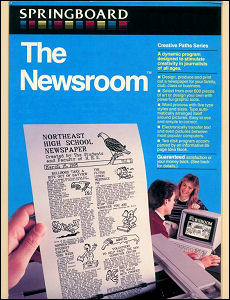 Springboard Software releases the computer publishing software suite The Newsroom for the Apple II home computer system, a very early example of a desktop publishing system, complete with the ability to transfer files to, and collaborate with, users of the same software on other platforms such as the Commodore 64.
Springboard Software releases the computer publishing software suite The Newsroom for the Apple II home computer system, a very early example of a desktop publishing system, complete with the ability to transfer files to, and collaborate with, users of the same software on other platforms such as the Commodore 64. ![]()
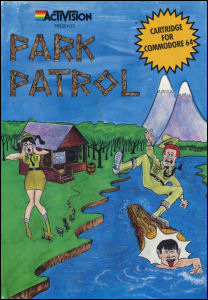 Activision releases Park Patrol for Commodore 64 home computers
Activision releases Park Patrol for Commodore 64 home computers ![]()
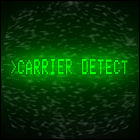 Massachusetts computer manufacturer Symbolics Inc., a maker of LISP-based computers with customers ranging from the Defense Advanced Research Projects Agency (DARPA) to movie studios, registers the first .com internet domain name, symbolics.com. Ironically, despite being further ahead of the internet curve than nearly any other commercial entity, Symbolics struggles to last into the 1990s; both the company’s assets and its domain name will be sold off in the 21st century.
Massachusetts computer manufacturer Symbolics Inc., a maker of LISP-based computers with customers ranging from the Defense Advanced Research Projects Agency (DARPA) to movie studios, registers the first .com internet domain name, symbolics.com. Ironically, despite being further ahead of the internet curve than nearly any other commercial entity, Symbolics struggles to last into the 1990s; both the company’s assets and its domain name will be sold off in the 21st century.
 Mindscape releases the educational computer game The Halley Project for the Apple II home computer system, designed by Omar Khudari and Tom Snyder. The game’s release is timed to coincide with increasing public awareness of the upcoming appearance of Halley’s Comet in 1986.
Mindscape releases the educational computer game The Halley Project for the Apple II home computer system, designed by Omar Khudari and Tom Snyder. The game’s release is timed to coincide with increasing public awareness of the upcoming appearance of Halley’s Comet in 1986. ![]()
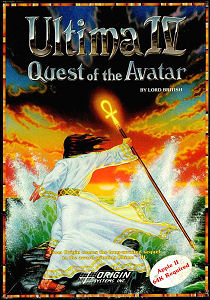 Origin Systems releases the role-playing game Ultima IV: Quest Of The Avatar for the Apple II home computer, the fourth in Richard Garriott’s Ultima series.
Origin Systems releases the role-playing game Ultima IV: Quest Of The Avatar for the Apple II home computer, the fourth in Richard Garriott’s Ultima series. ![]()
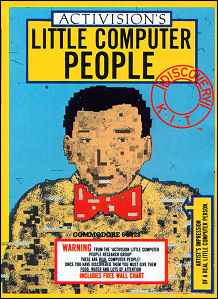 Electronic Arts releases the Little Computer People “discovery kit” for Commodore 64 home computers, enabling players to manage the “life” of a “Little Computer Person” residing within their home computer.
Electronic Arts releases the Little Computer People “discovery kit” for Commodore 64 home computers, enabling players to manage the “life” of a “Little Computer Person” residing within their home computer. ![]()
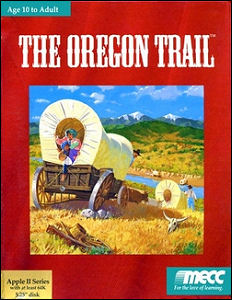 The Minnesota Educational Computing Corporation releases a new version of the perennial favorite educational computer game The Oregon Trail for the Apple II computer. Now featuring more action-based sequences than purely textual interactions, this version of The Oregon Trail is the most recognizable iteration of the game, which will be ported to numerous other computer systems.
The Minnesota Educational Computing Corporation releases a new version of the perennial favorite educational computer game The Oregon Trail for the Apple II computer. Now featuring more action-based sequences than purely textual interactions, this version of The Oregon Trail is the most recognizable iteration of the game, which will be ported to numerous other computer systems. ![]()
 Electronic Arts releases the game development toolkit Adventure Construction Set for the Apple II home computer, allowing users to design their own tile-based computer RPGs, defining characters, settings, weapons, magic use, and more.
Electronic Arts releases the game development toolkit Adventure Construction Set for the Apple II home computer, allowing users to design their own tile-based computer RPGs, defining characters, settings, weapons, magic use, and more. ![]()
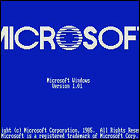 Microsoft introduces a graphical user interface for the IBM PC compatible computers, Windows 1.0. Essentially a GUI shell for Microsoft’s MS-DOS operating system, Windows arrives over two years after it was initially announced in 1983. To avoid legal entanglements with Apple (which has already launched a more visually-pleasing user interface with its Macintosh computers), Microsoft deliberately omits such now common features as overlapping or resizeable windows. Due to the amount of RAM in most users’ PCs, Windows’ multitasking ability is extremely limited.
Microsoft introduces a graphical user interface for the IBM PC compatible computers, Windows 1.0. Essentially a GUI shell for Microsoft’s MS-DOS operating system, Windows arrives over two years after it was initially announced in 1983. To avoid legal entanglements with Apple (which has already launched a more visually-pleasing user interface with its Macintosh computers), Microsoft deliberately omits such now common features as overlapping or resizeable windows. Due to the amount of RAM in most users’ PCs, Windows’ multitasking ability is extremely limited.
 Mindscape releases RACTER for the Apple II home computer, a program originally promoted as an early example of artificial intelligence, but whose packaging claims it to be a parody of artificial intelligence.
Mindscape releases RACTER for the Apple II home computer, a program originally promoted as an early example of artificial intelligence, but whose packaging claims it to be a parody of artificial intelligence. ![]()
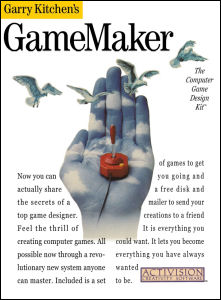 Activision releases the game development toolkit Garry Kitchen’s GameMaker for the Apple II home computer, allowing users to design their own computer games, including animated sprites, music, and more.
Activision releases the game development toolkit Garry Kitchen’s GameMaker for the Apple II home computer, allowing users to design their own computer games, including animated sprites, music, and more. ![]()
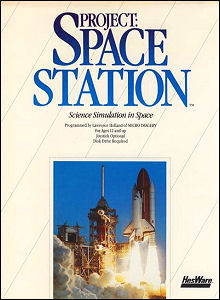 HESware releases the resource management game Project Space Station for the Apple II home computer, designed by Lawrence Holland (X-Wing vs. TIE Fighter). The game involves using a fleet of two space shuttles – Columbia and Challenger – to build the U.S. space station.
HESware releases the resource management game Project Space Station for the Apple II home computer, designed by Lawrence Holland (X-Wing vs. TIE Fighter). The game involves using a fleet of two space shuttles – Columbia and Challenger – to build the U.S. space station. ![]()
 Polarware (formerly Penguin Software) releases a remake of the adventure game Oo-Topos for the Apple II home computer.
Polarware (formerly Penguin Software) releases a remake of the adventure game Oo-Topos for the Apple II home computer. ![]()
 NASA releases an interactive electronic educational guide to the upcoming Hubble Space Telescope for the Apple II computer. Featuring diagrams of the orbiting telescope’s construction, methods of communication with Earth, and how it gathers its images. The software is released ahead of HST’s launch aboard an upcoming shuttle flight.
NASA releases an interactive electronic educational guide to the upcoming Hubble Space Telescope for the Apple II computer. Featuring diagrams of the orbiting telescope’s construction, methods of communication with Earth, and how it gathers its images. The software is released ahead of HST’s launch aboard an upcoming shuttle flight. ![]()